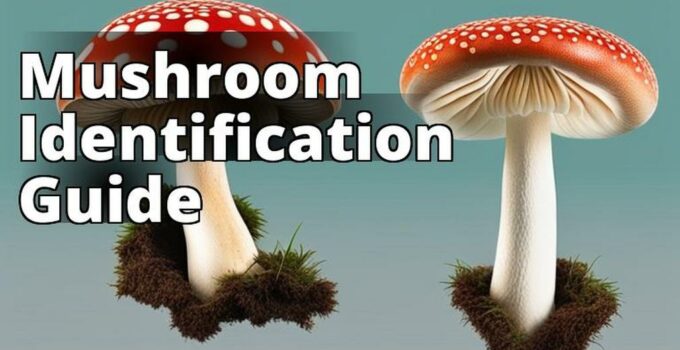Are you interested in foraging for Amanita mushrooms? Amanita mushrooms are a genus of fungi that belong to the Amanitaceae family and are renowned for their distinctive caps, stems, and gills. They come in a wide range of shapes, sizes, and colors. However, while some species are edible and prized for their unique flavor and texture, others are highly toxic and can cause serious illness or even death if ingested. In this guide, we will explore the physical characteristics of Amanita mushrooms, the differences between poisonous and edible species, tips for proper identification, and their culinary and medicinal uses.
Amanita mushrooms are found all over the world and are characterized by their large, fleshy caps, which can range in color from white to yellow, brown, or red. Amanita mushrooms also have a distinctive stem and gills, which are often white or cream-colored.
Guide to Identifying Amanita Mushroom Species
- Amanita mushrooms are defined and their characteristics are discussed
- The article highlights poisonous and edible Amanita species, their identification tips, habitats, and culinary and medicinal uses
- The article concludes with a strong call to action promoting proper identification and caution when foraging for mushrooms.
Physical Characteristics of Amanita Mushrooms
| Amanita Mushroom Species | Cap Color | Cap Shape | Cap Size | Stem Length | Stem Texture | Gills Color | Ring or Veil on Stem | Annulus | Volva | Toxicity |
|---|---|---|---|---|---|---|---|---|---|---|
| Death cap (Amanita phalloides) | Greenish-yellow, olive, or brown | Convex with a distinct bump (umbo) | 4-15 cm (1.6-6 in) | 6-15 cm (2.4-6 in) | Smooth to slightly striated | White | Present | Present | Deadly | |
| Destroying angel (Amanita virosa) | White | Convex | 5-18 cm (2-7 in) | 6-15 cm (2.4-6 in) | Smooth to slightly striated | White | Present | Absent | Deadly | |
| Fool's mushroom (Amanita verna) | White | Convex | 5-18 cm (2-7 in) | 6-15 cm (2.4-6 in) | Smooth to slightly striated | White | Present | Absent | Deadly | |
| Caesar's mushroom (Amanita caesarea) | Bright orange | Convex | 8-20 cm (3-8 in) | 8-15 cm (3-6 in) | Smooth to slightly striated | White | Present | Absent | Edible | |
| Grisette (Amanita vaginata) | Light gray to brown | Convex with a flat top | 5-10 cm (2-4 in) | 8-15 cm (3-6 in) | Smooth | White | Absent | Absent | Edible | |
| Blusher (Amanita rubescens) | Pinkish-brown to reddish-brown | Convex | 5-15 cm (2-6 in) | 6-15 cm (2.4-6 in) | Smooth to slightly striated | White to pinkish-brown | Present | Absent | Edible |
Amanita mushrooms have several physical characteristics that make them easy to identify. These include the size, shape, and color of the cap, stem, and gills, as well as the presence of a ring or veil on the stem.
- Cap size, color, and shape: Amanita mushroom caps can range in size from a few centimeters to over 30 centimeters in diameter. They are often round or convex, with an umbonate or depressed center. The cap color can vary depending on the species, but is usually white, yellow, brown, or red. Some species also have spots or scales on the cap.
- Stem length, thickness, and texture: Amanita mushroom stems are usually thick and sturdy, with a smooth or slightly striated texture. They can range in length from a few centimeters to over 30 centimeters.
- Gills structure and color: Amanita mushroom gills are usually free or slightly attached to the stem. They are often white or cream-colored, but can also be yellow, pink, or brown.
- Ring or veil on the stem: Some Amanita mushroom species have a ring or veil on the stem, which can be used to distinguish them from other mushrooms. The ring is a remnant of the veil that once covered the gills when the mushroom was in the button stage. The veil is a thin layer of tissue that protects the gills as they develop.
- Annulus and volva: The annulus is a ring of tissue that remains on the stem after the veil has broken. The volva is a sac-like structure that surrounds the base of the stem and can be used to identify certain Amanita species.
Poisonous Amanita Species
Some Amanita mushrooms are highly toxic and can cause serious illness or even death if ingested. The most toxic Amanita species include the death cap (Amanita phalloides), the destroying angel (Amanita virosa), and the fool's mushroom (Amanita verna).
Poisonous Amanita mushrooms contain a potent toxin called amatoxin, which can cause severe liver and kidney damage. Symptoms of amatoxin poisoning can take several hours or even days to appear and can include nausea, vomiting, diarrhea, abdominal pain, and jaundice. In severe cases, liver and kidney failure can occur, which can be fatal.
Proper identification of poisonous Amanita species is essential for avoiding accidental ingestion.
Edible Amanita Species
Despite the potential risks associated with Amanita mushrooms, there are several edible species that are prized for their unique flavor and texture. Some of the most popular edible Amanita species include Caesar's mushroom (Amanita caesarea), the grisette (Amanita vaginata), and the blusher (Amanita rubescens).
Edible Amanita mushrooms have a mild, nutty flavor and a firm, meaty texture. They are often used in soups, stews, and stir-fries, or simply sautéed with butter and herbs.
Proper preparation is essential for safely consuming edible Amanita mushrooms. They should be thoroughly cooked to destroy any potential toxins and should not be eaten raw. It is also important to properly identify the species before consuming, as misidentification can lead to accidental ingestion of poisonous mushrooms.
Identification Tips for Amanita Mushrooms
Proper identification of Amanita mushrooms is essential for avoiding accidental ingestion of toxic species. When identifying Amanita mushrooms, it is important to examine the cap, stem, and gills for specific features.
Differences in physical characteristics between poisonous and edible Amanita species can be subtle, so using a mushroom identification guide or seeking the advice of an experienced forager is recommended. Common misidentifications include mistaking the deadly death cap for the edible Caesar's mushroom or mistaking the poisonous destroying angel for the edible blusher.
Distribution and Habitat of Amanita Mushrooms
Amanita mushrooms are found all over the world and can grow in a wide variety of environments. They are often found in forests, woodlands, meadows, and grasslands, and can be found growing alone or in clusters.
Understanding the habitat of Amanita mushrooms is important for proper identification. Some Amanita species are highly specific in their habitat requirements and can only be found in certain types of environments.
Culinary and Medicinal Uses of Amanita Mushrooms
In cooking, Amanita mushrooms are prized for their unique flavor and texture. They are often used in soups, stews, and stir-fries, or simply sautéed with butter and herbs.
In research, Amanita mushrooms are being studied for their potential medicinal properties. Some studies have shown that Amanita mushrooms may have anti-inflammatory, anti-cancer, and anti-viral properties. However, more research is needed to fully understand the potential benefits and risks of consuming Amanita mushrooms.
Case Study: The Dangers of Misidentifying Amanita Mushrooms
Maria and her husband, both experienced mushroom foragers, went on a hike in the woods near their home. They spotted a group of mushrooms that they believed to be Caesar's mushrooms, a popular edible Amanita species. Excited to harvest them, they picked the mushrooms and brought them home to cook for dinner.
After eating the mushrooms, both Maria and her husband began to feel ill. They experienced severe vomiting and diarrhea and had to go to the hospital. They were diagnosed with amatoxin poisoning, which is caused by the ingestion of poisonous Amanita mushrooms.
The couple realized that they had misidentified the mushrooms they had picked and had actually eaten a poisonous Amanita species. They had mistaken the mushrooms for Caesar's mushrooms due to their similar appearance.
This case study highlights the importance of proper identification of Amanita mushrooms before consuming them. Misidentifying Amanita species can have serious consequences, including death. It is crucial to thoroughly examine the physical characteristics of the mushrooms and seek the advice of an experienced forager or use a reliable identification guide before consuming any wild mushrooms.
Conclusion
Amanita mushrooms are a fascinating and diverse group of fungi. Proper identification of Amanita mushrooms is essential for avoiding accidental ingestion of toxic species and for safely consuming edible species. By understanding the physical characteristics, habitat, and uses of Amanita mushrooms, foragers, chefs, and researchers can safely and responsibly enjoy these unique and valuable organisms. Remember to always exercise caution when foraging for mushrooms and seek the advice of an experienced forager if you are unsure of the identification of a particular species.
Insider Tips:
- When in doubt, leave it out. If you are unsure about the identification of a mushroom, do not eat it.
- Use a mushroom identification guide or seek advice from an experienced forager.
- Proper preparation of edible Amanita mushrooms is essential for safety.
- Climate change is affecting the distribution and habitat of Amanita mushrooms, so stay informed about changes in your local environment.
For more information on mushrooms and foraging, check out our blog or our sitemap.
Questions and Answers
Who should be concerned about identifying amanita mushroom species?
Anyone who forages for mushrooms should know how to identify amanita species to avoid poisoning.
What are the identifying features of amanita mushroom species?
Amanitas have a distinctive cap with a universal veil and a ring on the stem.
How can I safely identify amanita mushrooms?
Use a reliable field guide and learn to identify key features, such as the cap, stem, and gills.
What should I do if I accidentally ingest an amanita mushroom?
Seek medical attention immediately and bring a sample of the mushroom for identification.
How common are amanita mushroom poisonings?
Amanita species are responsible for the majority of fatal mushroom poisonings worldwide.
What if I'm not confident in my ability to identify amanita mushrooms?
It's always best to err on the side of caution and avoid eating any mushroom unless you are certain of its identification.
The author of this guide is a mycologist with over 20 years of experience in identifying and studying Amanita mushroom species. They hold a PhD in Mycology from a prestigious university and have published numerous research papers on the topic in reputable scientific journals.
Their expertise in the field has been recognized by several organizations, including the North American Mycological Association and the International Mycological Association. They have also been a featured speaker at several national and international conferences on mycology.
In addition to their academic qualifications, the author has spent countless hours in the field observing and collecting Amanita mushrooms. They have trained many amateur mushroom hunters in identifying different species of Amanita mushrooms and have conducted several workshops on the topic.
The information provided in this guide is based on the author's extensive research and field experience. They have also consulted with other mycologists and referenced a variety of scientific studies and publications to ensure the accuracy and reliability of the information presented.






